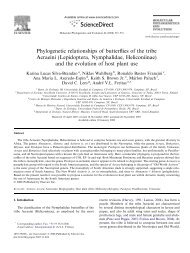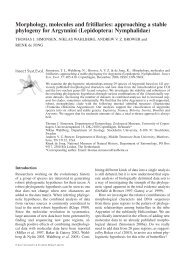The life history and ecology of Melitaea diamina (Nymphalidae) in ...
The life history and ecology of Melitaea diamina (Nymphalidae) in ...
The life history and ecology of Melitaea diamina (Nymphalidae) in ...
Create successful ePaper yourself
Turn your PDF publications into a flip-book with our unique Google optimized e-Paper software.
Fig. 4. A Valeriana sarnbucifolia plant that has been fed on by a group <strong>of</strong> 2nd <strong>in</strong>star<br />
M. <strong>diam<strong>in</strong>a</strong> larvae. <strong>The</strong> silk spun by the larvae is fairly <strong>in</strong>conspicuous, but the upper<br />
epidermis left uneaten by the larvae becomes conspicuous when it dries.<br />
I collected four groups <strong>of</strong> 2nd <strong>and</strong> 3rd <strong>in</strong>star larvae (613 <strong>in</strong>dividuals)<br />
<strong>and</strong> reared them to <strong>in</strong>vestigate the <strong>in</strong>cidence <strong>of</strong> parasitoids <strong>in</strong> M.<br />
<strong>diam<strong>in</strong>a</strong>. No parasitoids emerged from the larvae. It seems likely that<br />
specialist parasitoids are absent from the Tampere region, though <strong>in</strong><br />
Sweden M. <strong>diam<strong>in</strong>a</strong> is attacked by a braconid, Cotesia melitaearum<br />
(Wilk<strong>in</strong>son, 1937) (C. Eliasson, pers. comm.). <strong>The</strong> size <strong>of</strong> the M. <strong>diam<strong>in</strong>a</strong><br />
metapopulation <strong>in</strong> the Tampere region may be too small for a<br />
specialist parasitoid to persist, as has been suggested for some M. c<strong>in</strong>xia<br />
metapopulations (Lei & Hanski, 1997).<br />
4th <strong>in</strong>star larvae enter diapause towards the end <strong>of</strong> August. <strong>The</strong> larvae<br />
diapause <strong>in</strong> dead, curled leaves beneath the plant that they fed on.<br />
Usually a larval group splits <strong>in</strong>to smaller groups <strong>of</strong> 20 to 30 <strong>in</strong>dividuals<br />
that diapause with<strong>in</strong> adjacent leaves. 4th <strong>in</strong>star larvae no longer feed<br />
even if conditions are favourable.<br />
POSTDIAPAUSE LARVAE. Larvae term<strong>in</strong>ate diapause soon after the<br />
snow melts, which usually happens around the beg<strong>in</strong>n<strong>in</strong>g <strong>of</strong> May <strong>in</strong>





